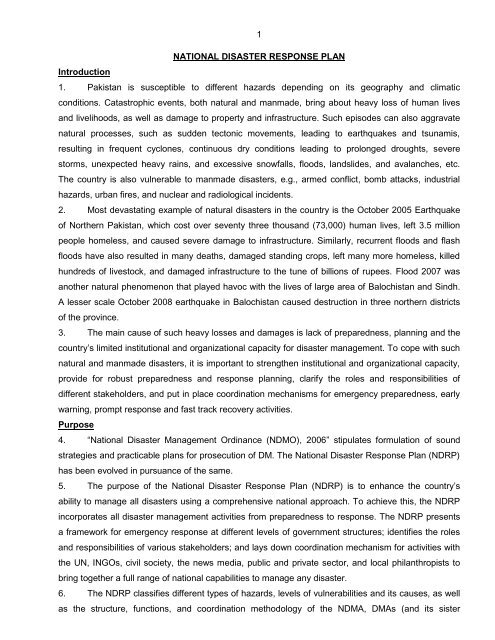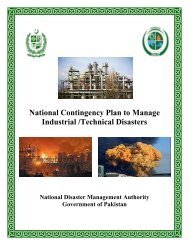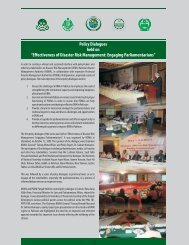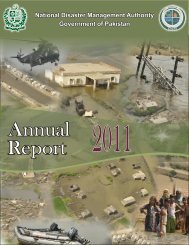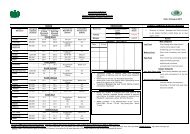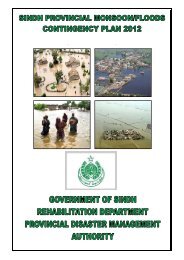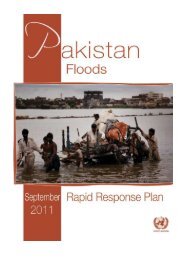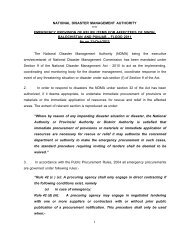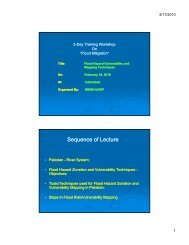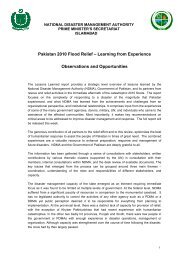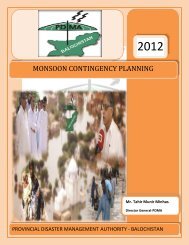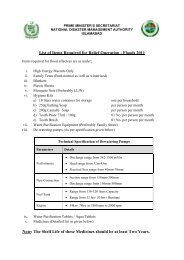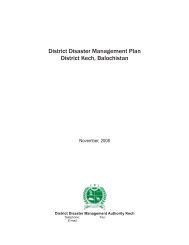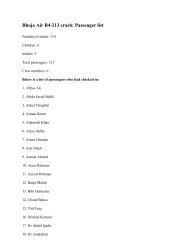National Disaster Response Plan (NDRP) March 2010 - NDMA
National Disaster Response Plan (NDRP) March 2010 - NDMA
National Disaster Response Plan (NDRP) March 2010 - NDMA
Create successful ePaper yourself
Turn your PDF publications into a flip-book with our unique Google optimized e-Paper software.
Introduction<br />
1<br />
NATIONAL DISASTER RESPONSE PLAN<br />
1. Pakistan is susceptible to different hazards depending on its geography and climatic<br />
conditions. Catastrophic events, both natural and manmade, bring about heavy loss of human lives<br />
and livelihoods, as well as damage to property and infrastructure. Such episodes can also aggravate<br />
natural processes, such as sudden tectonic movements, leading to earthquakes and tsunamis,<br />
resulting in frequent cyclones, continuous dry conditions leading to prolonged droughts, severe<br />
storms, unexpected heavy rains, and excessive snowfalls, floods, landslides, and avalanches, etc.<br />
The country is also vulnerable to manmade disasters, e.g., armed conflict, bomb attacks, industrial<br />
hazards, urban fires, and nuclear and radiological incidents.<br />
2. Most devastating example of natural disasters in the country is the October 2005 Earthquake<br />
of Northern Pakistan, which cost over seventy three thousand (73,000) human lives, left 3.5 million<br />
people homeless, and caused severe damage to infrastructure. Similarly, recurrent floods and flash<br />
floods have also resulted in many deaths, damaged standing crops, left many more homeless, killed<br />
hundreds of livestock, and damaged infrastructure to the tune of billions of rupees. Flood 2007 was<br />
another natural phenomenon that played havoc with the lives of large area of Balochistan and Sindh.<br />
A lesser scale October 2008 earthquake in Balochistan caused destruction in three northern districts<br />
of the province.<br />
3. The main cause of such heavy losses and damages is lack of preparedness, planning and the<br />
country‟s limited institutional and organizational capacity for disaster management. To cope with such<br />
natural and manmade disasters, it is important to strengthen institutional and organizational capacity,<br />
provide for robust preparedness and response planning, clarify the roles and responsibilities of<br />
different stakeholders, and put in place coordination mechanisms for emergency preparedness, early<br />
warning, prompt response and fast track recovery activities.<br />
Purpose<br />
4. “<strong>National</strong> <strong>Disaster</strong> Management Ordinance (NDMO), 2006” stipulates formulation of sound<br />
strategies and practicable plans for prosecution of DM. The <strong>National</strong> <strong>Disaster</strong> <strong>Response</strong> <strong>Plan</strong> (<strong>NDRP</strong>)<br />
has been evolved in pursuance of the same.<br />
5. The purpose of the <strong>National</strong> <strong>Disaster</strong> <strong>Response</strong> <strong>Plan</strong> (<strong>NDRP</strong>) is to enhance the country‟s<br />
ability to manage all disasters using a comprehensive national approach. To achieve this, the <strong>NDRP</strong><br />
incorporates all disaster management activities from preparedness to response. The <strong>NDRP</strong> presents<br />
a framework for emergency response at different levels of government structures; identifies the roles<br />
and responsibilities of various stakeholders; and lays down coordination mechanism for activities with<br />
the UN, INGOs, civil society, the news media, public and private sector, and local philanthropists to<br />
bring together a full range of national capabilities to manage any disaster.<br />
6. The <strong>NDRP</strong> classifies different types of hazards, levels of vulnerabilities and its causes, as well<br />
as the structure, functions, and coordination methodology of the <strong>NDMA</strong>, DMAs (and its sister


